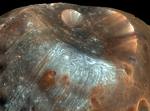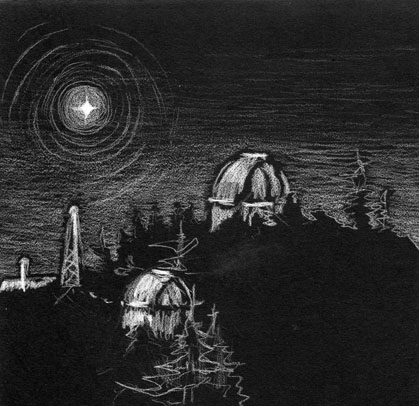
Images from the recent close flyby of Mars’ moon Phobos, which took place on March 7, were released March 15. The images show the rocky, irregular-shaped moon in exquisite detail, with a resolution of just 4.4 meters (about 5 yards) per pixel. They also show the proposed landing sites for Russia’s forthcoming Phobos-Grunt mission.
Images from the flyby are available at:
http://www.esa.int/esaSC/SEMK17CKP6G_index_0.html
The Mars Express spacecraft is operated by the European Space Agency (ESA). The flight control team is located at the European Space Operations Centre in Darmstadt, Germany. Mars Express orbits the Red Planet in a highly elliptical, polar orbit that brings it close to Phobos every five months. It is the only spacecraft currently in orbit around Mars whose orbit reaches far enough from the planet to provide a close-up view of Phobos.
Like Earth’s Moon, Phobos does not rotate, but always shows the same side to the planet. Therefore it is only by flying outside Phobos’ orbit that it becomes possible to observe the far side. Mars Express did just this on March 7, 10, and 13. The spacecraft also collected data with other instruments.
The names of Mars’ two moons, Phobos (meaning “fear”) and Deimos (meaning “dread”) are taken from Greek mythology. In Homer’s Iliad, Phobos and Deimos were the names of two sons of Ares (Mars), the god of war. Phobos is the larger of the two moons, and its orbit is closer to Mars than that of Deimos.
Phobos is an irregular body measuring some 27 by 22 by 19 km. Its origin is debated. It appears to share many surface characteristics with the class of “carbonaceous C-type” asteroids, which suggests it might have been captured from this population. However, it is difficult to explain either the capture mechanism or the subsequent evolution of the orbit into the equatorial plane of Mars. An alternative hypothesis is that it formed around Mars, and is therefore a remnant from the planetary formation period.
In 2011, Russia will send a mission called Phobos-Grunt (meaning “Phobos Soil”) to land on the Martian moon, collect a soil sample, and return it to Earth for analysis.
For operational and landing safety reasons, the proposed Russian landing sites were selected on the far side of Phobos within the area 5°S-5°N, 230-235°E. This region was imaged by the HRSC high-resolution camera of Mars Express during the July-August 2008 flybys of Phobos. But new HRSC images showing the vicinity of the landing area under different conditions, such as better illumination from the Sun, remain highly valuable for mission planners.
It is expected that Earth-based ESA stations will take part in controlling Phobos-Grunt, receiving telemetry and making trajectory measurements, including implementation of very long-baseline interferometry, an astronomical technique that uses two or more widely spaced telescopes operating simultaneously to achieve very high resolution. This cooperation is realized on the basis of an agreement on collaboration of the Russian Federal Space Agency and ESA.
Mars Express will continue to encounter Phobos until the end of March, when the Martian moon’s orbit will take it out of the spacecraft’s range.
Updates as the flybys take place will be posted on the Mars Express blog at:
http://webservices.esa.int/blog/blog/7
You can contact Bob Eklund at www.bobeklund.com. “Looking Up” is reprinted courtesy of the Mountain View News.





Be the first to comment